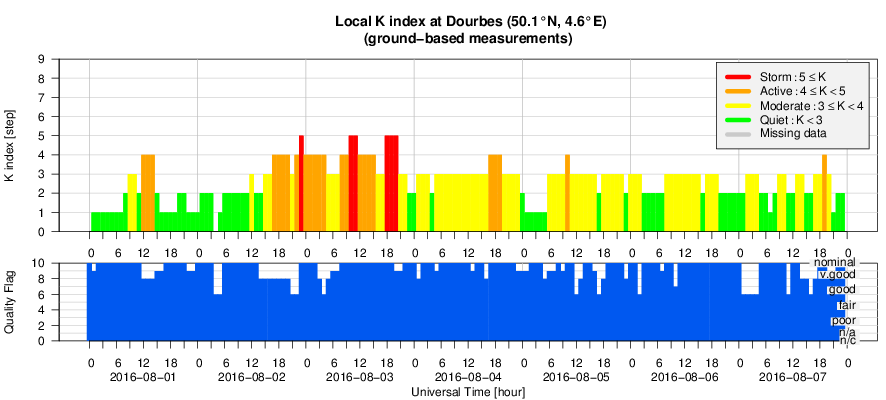- Table of Content
- 1.You can help d...
- 2.Sun-grazing co...
- 3.PROBA2 Observa...
- 4.Review of sola...
- 5.The Internatio...
- 6.Noticeable Sol...
- 7.Review of geom...
- 8.Geomagnetic Ob...
- 9.Review of iono...
- 10.Future Events
2. Sun-grazing comet mystery
3. PROBA2 Observations (1 Aug 2016 - 7 Aug 2016)
4. Review of solar activity
5. The International Sunspot Number
6. Noticeable Solar Events (1 Aug 2016 - 7 Aug 2016)
7. Review of geomagnetic activity
8. Geomagnetic Observations at Dourbes (1 Aug 2016 - 7 Aug 2016)
9. Review of ionospheric activity (1 Aug 2016 - 7 Aug 2016)
10. Future Events
You can help detecting meteors
Like every year, Earth passes at this very moment through the trajectory of the Perseid dust cloud left behind by the comet Swift-Tuttle. Part of this dust plunges into the Earth atmosphere giving us a night sky filled with bright falling stars.
Falling stars are in fact meteors and not really stars. Meteors can also be heart when transmitted radio signals bounce back on them and mark in this way the presence of a meteor. At the space pool, scientists are eager to detect meteors through this technique. The received signals are put in a typical BRAMS graph.
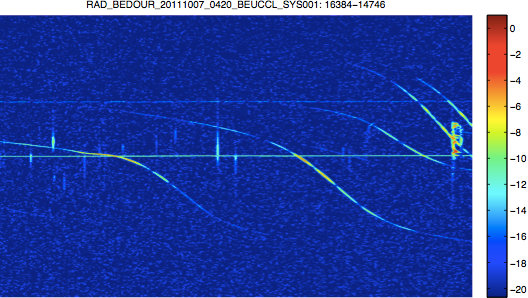
BRAMS is the name of this scientific project. These graphs need to be interpreted and analysed to map for example the activity of the Perseid meteorswarm and check when the meteor shower peaks. For this, the BRAMS scientists need as much help as possible, for example from you: http://www.radiometeorzoo.eu
Everybody can do this and it’s fun to do!
At the moment of writing it is still possible to enjoy the Perseid falling stars live: find a dark place outside, lay on your back and enjoy. The shower will peak on August 11-12. Late night is the best time.
For more science background on BRAMS, check the website: http://brams.aeronomy.be
Sun-grazing comet mystery
Did the EUV space telescope onboard PROBA2 see the sun-grazing comet as a tiny dot on the solar surface lightening up? This is the story of 5 mysterious pixels.
How it began: on August 4, a very bright Kreutz Comet made a crashing collapse on the Sun.
It came into the view of the coronograph LASCO C2 onboard SOHO at the start of the UT day. It flew through its field of view, the comet itself passed the inner LASCO boundaries around 4UT, while the dust tail disappeared completely by 11UT. The ESA satellite PROBA2 was like always also keeping an eye on the EUV sun. PROBA2 didn’t see any obvious comets flying though the field of view. But at 05:02:42, 5 pixels at the west limb lighted up.
This is a PROBA2/SWAP image combined with a LASCO/C2 images. The comet is visible at the right, the mysterious pixel brightening in the blue rectangular.
Because we couldn't get enough from these mysterious pixels, we made a close up:
The brightening is visible in only 1 image. PROBA2 makes pictures roughly every 2 minutes. The timing could coincide with the comet crashing into the Sun. Exciting! The pixel-comet lightening could not be confirmed yet with other observations. It was really a pity that SDO was not observing at that moment :-(
We made also other cool stuff: PROBA2 EUV and LASCO C2 difference images of in LogPolar coordinates.
For LogPolar coordinates, we cut along a radius, open and bend the circle such that we get a straight solar surface. The picture is the most stretched near the centre of the solar disc.
Here is the YouTube movie: https://youtu.be/2_YAGXFgRPs
You can make your own movies with the app JHelioviewer. Get it on http://www.jhelioviewer.org Don't forget to try it!
It has two tails and moves through space. What is it?
Before answering this question, this. A comet has 2 tails: a dust and an ion tail. The ion tail exist out of gas to becomes ionised because of the solar radiation and follows the laws of the solar wind and magnetic forces. The dust tail behaves accordingly to the laws of Kepler where gravity rules. Dust particles leave their gaseous residence around the nucleus of the comet, i.e. the coma under the influence of the solar radiation force.
In SOHO/LASCO we see the dust tail, in fact the light scattered by it. It is the dust tail because it is very intense and follows the projection of the trajectory of the comet. While an ion tail would be more faint, quasi radial and we don’t see fibrous structures associated to the interplanetary magnetic field.
So, now you know: it has two tails and moves through space. What is it? A comet!
And this one made and still makes us puzzling and discussing amongst each other.
PROBA2 Observations (1 Aug 2016 - 7 Aug 2016)
Solar Activity
Solar flare activity fluctuated between very low and moderate during the week.
In order to view the activity of this week in more detail, we suggest to go to the following website from which all the daily (normal and difference) movies can be accessed: http://proba2.oma.be/ssa
This page also lists the recorded flaring events.
A weekly overview movie can be found here (SWAP week 332).
proba2.oma.be/swap/data/mpg/movies/weekly_movies/weekly_movie_2016_08_01.mp4
Details about some of this week's events, can be found further below.
If any of the linked movies are unavailable they can be found in the P2SC movie repository here
http://proba2.oma.be/swap/data/mpg/movies/
Tuesday Aug 02
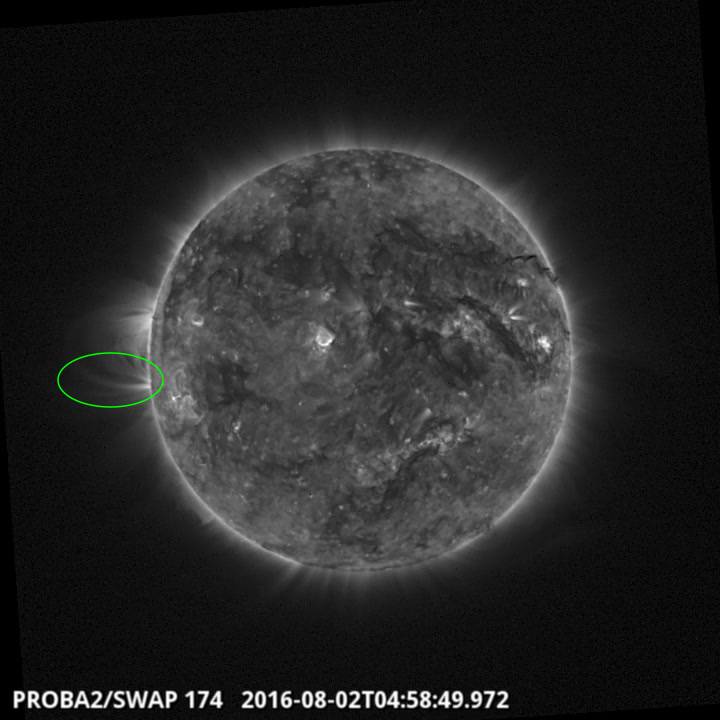
An eruption was observed by SWAP on the east limb of the Sun on 2016Aug02 at 04:58 UT
Find a movie of the event here (SWAP movie)
proba2.oma.be/swap/data/mpg/movies/20160802_swap_movie.mp4
Sunday Aug 07
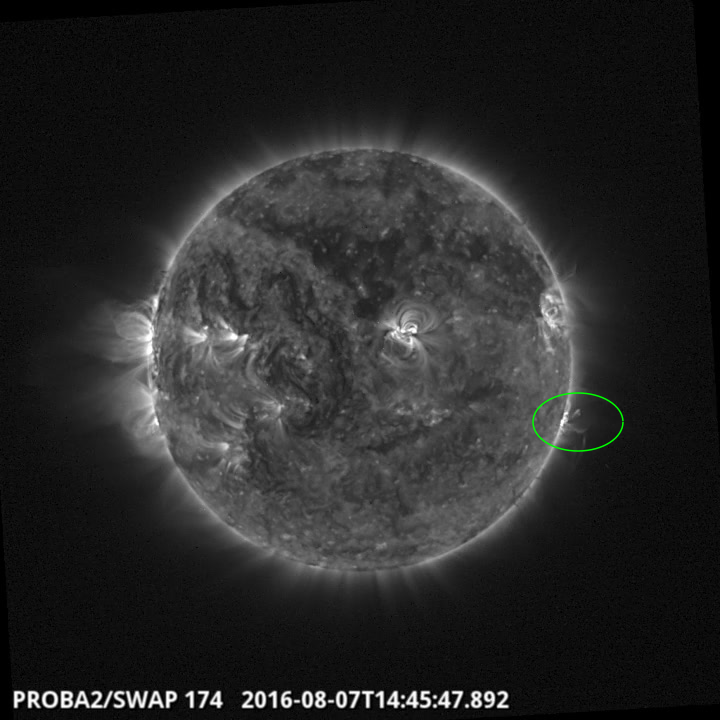
An eruption was observed by SWAP on the west limb of the Sun on 2016Aug07 at 14:45 UT
Find a movie of the event here (SWAP movie)
http://proba2.oma.be/swap/data/mpg/movies/20160807_swap_movie.mp4
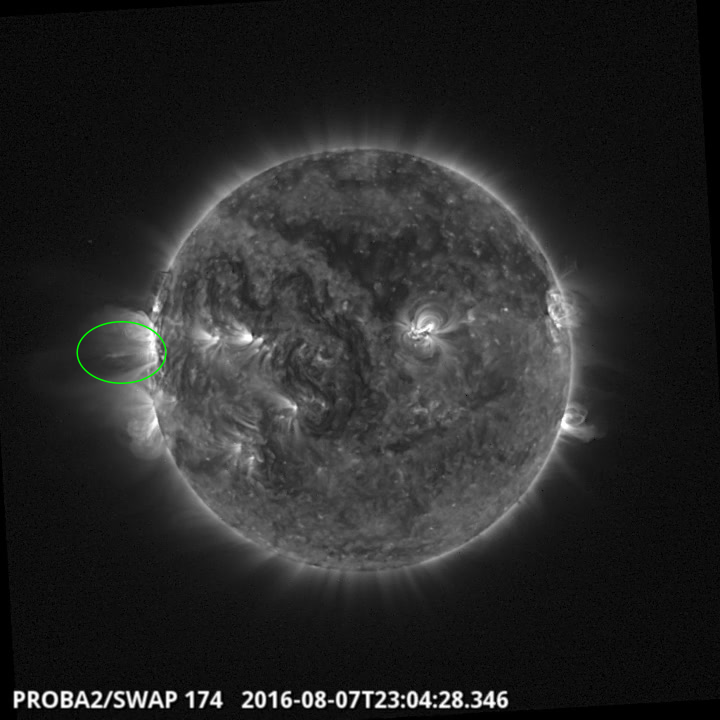
An eruption was observed by SWAP on the east limb of the Sun on 2016Aug07 at 23:04 UT
Find a movie of the event here (SWAP movie)
http://proba2.oma.be/swap/data/mpg/movies/20160807_swap_movie.mp4
Review of solar activity
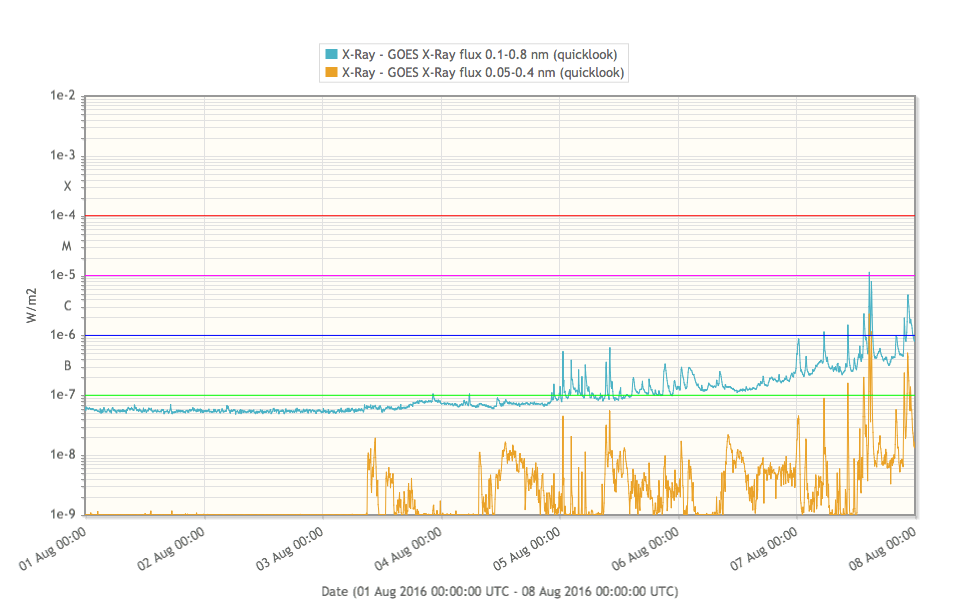
The Sun released 9 C flares and 1 M flare during this week. Most of the week was very quiet, with the GOES X ray background below B level and no C flaring. Apart from a low C flare on August 5, all C and M flaring happened on the last day of the week, August 7, when a region on the west limb produced an M1.3 flare, shortly followed by a C8.5 flare by NOAA AR 2572 and 2573, along with lower C flares.
The International Sunspot Number
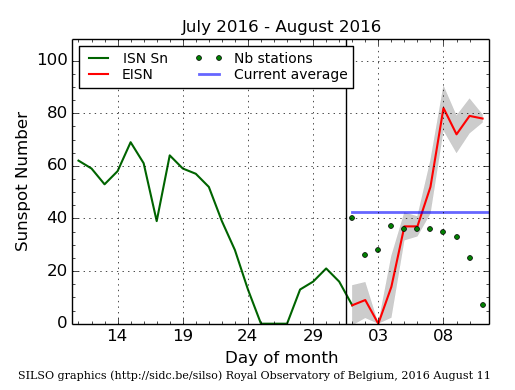
The daily Estimated International Sunspot Number (EISN, red curve with shaded error) derived by a simplified method from real-time data from the worldwide SILSO network. It extends the official Sunspot Number from the full processing of the preceding month (green line). The plot shows the last 30 days (about one solar rotation). The horizontal blue line shows the current monthly average, while the green dots give the number of stations included in the calculation of the EISN for each day.
Noticeable Solar Events (1 Aug 2016 - 7 Aug 2016)
| DAY | BEGIN | MAX | END | LOC | XRAY | OP | 10CM | TYPE | Cat | NOAA |
| 07 | 1437 | 1444 | 1448 | M1.3 |
| LOC: approximate heliographic location | TYPE: radio burst type |
| XRAY: X-ray flare class | Cat: Catania sunspot group number |
| OP: optical flare class | NOAA: NOAA active region number |
| 10CM: peak 10 cm radio flux |
Review of geomagnetic activity
Solar wind speed measured by DSCOVR suddenly increased from about 350 to 380 km/s around 12UT on August 2, and gradually further to a maximum of about 460 km/s. The solar wind density and the Interplanetary Magnetic Field strength had been rising since about 4UT to a maximum of about 40 particles per cc and 25 nT, respectively. This was most probably due to the arrival of the CME of July 28.
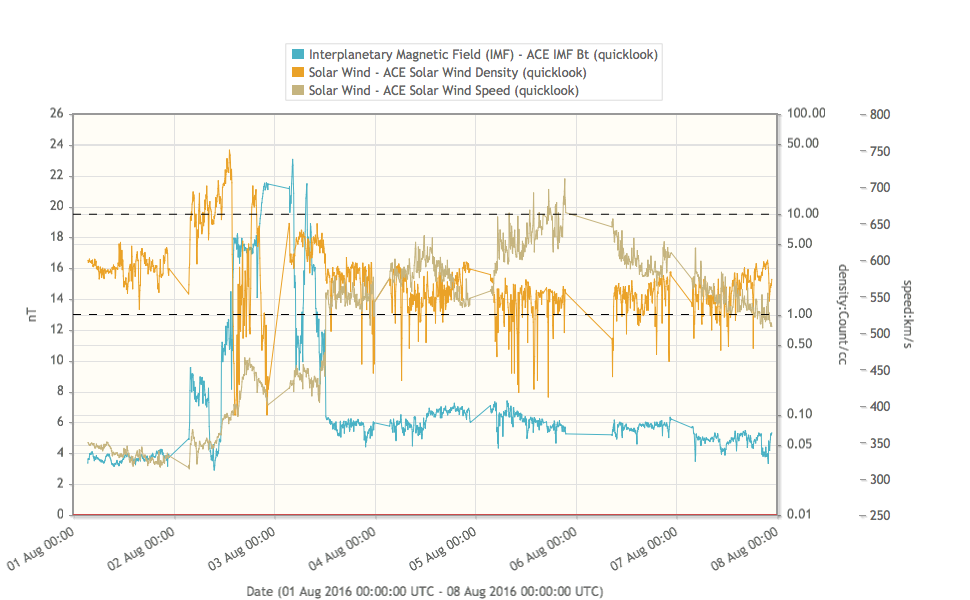
A sudden increase in solar wind speed from about 430 to 580 km/s was detected between 12UT and 14UT on August 3, indicating the arrival of a high speed stream associated with a positive coronal hole. Later, the solar wind speed again increased to about 720 km/s while the Interplanetary Magnetic Field strength stayed around 5 nT.
At the end of the week, solar wind speed had decreased to 500 km/s.
These solar wind conditions led to active and minor storm intervals (K Dourbes = 4-5) around August 3.
Review of ionospheric activity (1 Aug 2016 - 7 Aug 2016)
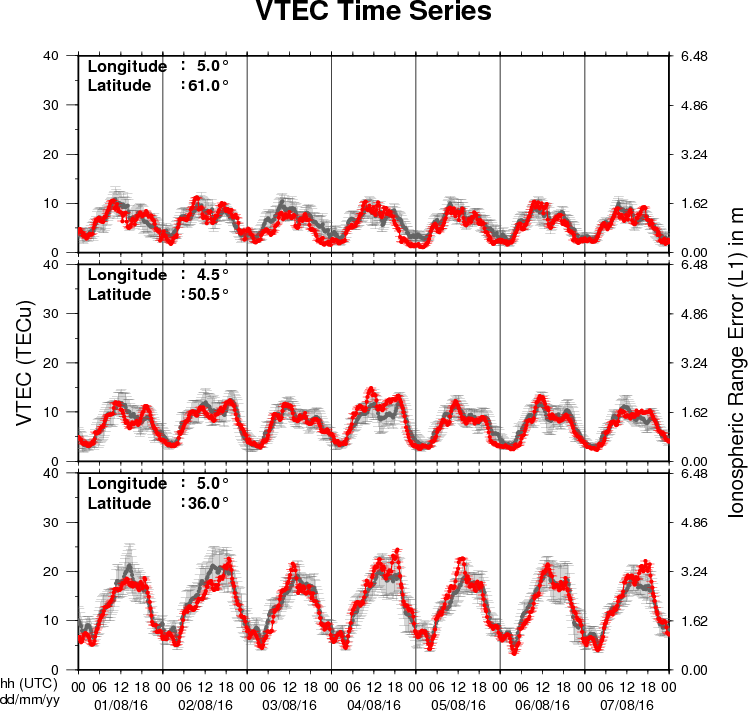
The figure shows the time evolution of the Vertical Total Electron Content (VTEC) (in red) during the last week at three locations:
a) in the northern part of Europe(N61°, 5°E)
b) above Brussels(N50.5°, 4.5°E)
c) in the southern part of Europe(N36°, 5°E)
This figure also shows (in grey) the normal ionospheric behaviour expected based on the median VTEC from the 15 previous days.
The VTEC is expressed in TECu (with TECu=10^16 electrons per square meter) and is directly related to the signal propagation delay due to the ionosphere (in figure: delay on GPS L1 frequency).
The Sun's radiation ionizes the Earth's upper atmosphere, the ionosphere, located from about 60km to 1000km above the Earth's surface.The ionization process in the ionosphere produces ions and free electrons. These electrons perturb the propagation of the GNSS (Global Navigation Satellite System) signals by inducing a so-called ionospheric delay.
See http://stce.be/newsletter/GNSS_final.pdf for some more explanations ; for detailed information, see http://gnss.be/ionosphere_tutorial.php
Future Events
For more details, see http://www.spaceweather.eu/en/event/future
Horizon 2020 Space Work Programme 2018-2020 Stakeholder Consultation Workshop, in Brussels, Belgium
Start : 2016-09-26 - End : 2016-09-28
In the context of preparing the Horizon 2020 Space work
programme 2018-2020, the European Commission organises a dedicated
stakeholder consultation workshop. The main objective of this event
is to further involve all relevant European stakeholders in the
definition of the next Horizon 2020 Space work programme,
highlighting the main priorities and trends.
The participation to the workshop is free and open to all
relevant stakeholders, limited only by the capacity of the
conference rooms. Delegations, European associations and other
stakeholder groups are encouraged to forward this invitation to
their respective constituents and members.
Website:
https://h2020-space-wp-2018-20.teamwork.fr/en/programme
4th Asia Oceania Space Weather Alliance (AOSWA) Workshop, in Jeju, Republic of Korea
Start : 2016-10-24 - End : 2016-10-27
Website:
http://aoswa4.spaceweather.org/index.php
Global Modelling of the Space Weather Chain in Helsinki, Finland
Start : 2016-10-24 - End : 2016-10-28
This event brings together solar, heliospheric, magnetospheric,
and ionospheric communities to discuss the current state and future
challenges in global modelling of the entire space weather chain.
Major developments in forecasting space weather, and understanding
the effects of solar eruptions requires increased communication and
collaboration of these often rather distinct communities. We
welcome submissions from these modelling communities and also
synergetic studies utilising both observations and numerical
models.
Website:
https://pnst.ias.u-psud.fr/sites/pnst/files/global_modelling_space_weather_oct2016.pdf
European Space Weather Week in Ostend, Belgium
Start : 2016-11-14 - End : 2016-11-18
The ESWW is the main annual event in the European Space Weather
calendar. It is the European forum for Space Weather as proven by
the high attendance to the past editions. The agenda will be
composed of plenary/parallel sessions, working meetings and
dedicated events for service end-users. The ESWW will again adopt
the central aim of bringing together the diverse groups in Europe
working on different aspects of Space Weather.
Website:
http://www.stce.be/esww13/
4th SOLARNET Meeting: The Physics of the Sun from the Interior to the Outer Atmosphere, in Lanzarote (Spain)
Start : 2017-01-16 - End : 2017-01-20
The IV SOLARNET MEETING 'The physics of the Sun from the
interior to the outer atmosphere' will take place in Lanzarote
(Spain) from 16th to 20th of January 2017, organized by the
Instituto de AstrofÃsica de Canarias (IAC).
SOLARNET (High-resolution Solar Physics Network) is an EU-FP7
project coordinated by IAC with the aim of bringing together and
integrating the major European research infrastructures in the
field of high-resolution solar physics. SOLARNET involves all
pertinent European research institutions, infrastructures, and data
repositories. Networking activities, access to first-class
infrastructures and joint research and development activities are
being covered under SOLARNET to improve, in quantity and quality,
the service provided by this European community.
The purpose of this conference is to provide a coherent picture
of the Sun as a single physical system playing all the underlying
physical processes measured and observed in the solar atmosphere to
date.
Website:
http://www.iac.es/congreso/solarnet-4meeting/
Solar Orbiter Workshop 7: Exploring the solar environs in Granada, Spain
Start : 2017-04-03 - End : 2017-04-06
This event will be hosted by the Instituto de Astrofisica de
Andalucia - CSIC. Please mind that on April 7th the 20th SWT
meeting will take place at the same venue.
Website: Unkown
